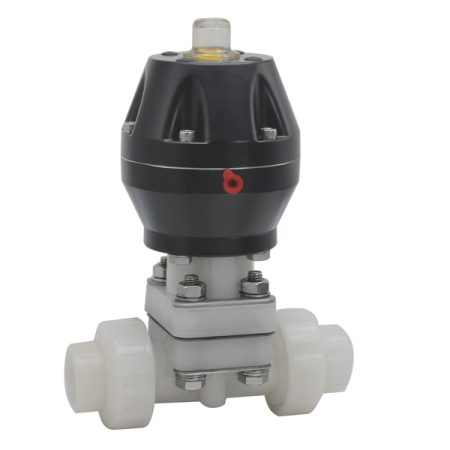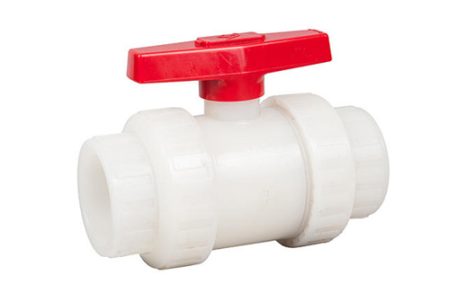
You use PVDF ball valves to control acids and alkalis. These valves work well with strong chemicals in tough places. PVDF ball valves resist chemicals and last a long time. This means they keep working even after being in harsh areas for years. Many engineers pick PVDF ball valves for these reasons:
- They handle strong acids, bases, and many chemicals.
- Their strength helps them last three times longer than other plastic valves.
- They need less fixing because their smooth insides stop buildup and clogs.
PVDF is also used in other valves, like butterfly valves and pneumatic control valves. These valves help you control flow in hard situations.
PVDF Ball Valve Material
Chemical Resistance
PVDF ball valves are special because they resist chemicals well. You can use them with many strong chemicals and not worry about damage. PVDF stays stable when it touches acids, alkalis, and solvents. This is why chemical plants and labs like to use it.
Acids
When you work with acids, you need a valve that does not get ruined. PVDF ball valves can handle many acids, like acetic acid and sulfuric acid. The table below shows how PVDF works with different chemicals at different temperatures:
| Chemical | 20°C/68°F | 60°C/140°F | 100°C/212°F |
|---|---|---|---|
| Acetic acid (10%) | R | R | R |
| Sulphuric acid (<50%) | R | R | R |
| Aqua regia | R | R | NR |
| Alcohols | R | R | R |
| Water, distilled | R | R | R |
Tip: “R” means resistant. You can trust PVDF valves with these acids at most temperatures.
Alkalis
You also need to be safe from alkalis. PVDF ball valves protect against many bases. They work with both strong and weak alkalis. You can use them with sodium hydroxide or potassium hydroxide. PVDF helps stop leaks and breaks, even after many years.
Durability
You want a valve that lasts a long time. PVDF is strong and can be used again and again. It has a design stress of 1,360 psi at 73°F. PVDF also resists scratches and hits. These valves keep working with tough chemicals and hard use. They last longer than metal or normal plastic valves.
- PVDF is hard and does not scratch easily.
- It does not get ruined by the environment.
- It keeps its shape and strength under pressure.
Temperature Tolerance
Heat and cold can change how some valves work, but PVDF ball valves handle heat well. You can use them up to 280°F and they still resist chemicals. This makes them good for hot chemical jobs. The table below shows how temperature changes can affect the valve:
| Aspect | Impact |
|---|---|
| Material Integrity | High heat can make parts bigger; cold can make them break easier. |
| Sealing Performance | Seals might change shape or get harder with temperature changes. |
| Fluid Characteristics | Temperature changes how fluids move and react. |
| Mechanical Stress | Parts can get stressed from getting bigger or smaller. |
| Thermal Expansion | Parts might move, which can change how they seal. |
Note: Always check your system’s temperature limits. PVDF valves work well in both hot and cold places.
Ball Valves for Corrosive Media
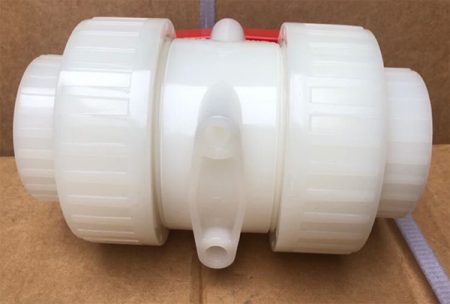
Handling Aggressive Substances
In the chemical industry, you often use strong chemicals. Ball valves for corrosive media help keep these chemicals under control. PVDF ball valves work with many strong acids and bases. You can use them with:
- Hydrochloric Acid (HCl)
- Hydrofluoric Acid (HF)
- Sulfuric Acid (H2SO4)
- Nitric Acid (HNO3)
- Acetic Acid (CH3COOH)
- Chlorine (Cl2)
- Phosgene (COCl2)
- Alkali, such as Sodium Hydroxide (NaOH)
- Ammonia (NH3)
- Saltwater
PVDF ball valves are used in real chemical plants. For example, they move 93% sulfuric acid and 49% hydrofluoric acid. These systems use double containment for extra safety. Many places pick PVDF ball valves because they last longer and save money. They work well even with very harsh chemicals.
Tip: PVDF ball valves help stop leaks and failures when you use dangerous fluids.
Corrosion in Ball Valves
Corrosion in ball valves can cause big trouble. You need to know what causes corrosion to keep your system safe. The table below shows the main reasons for corrosion in ball valves:
| Cause of Corrosion | Description |
|---|---|
| Environmental exposure | Corrosion happens when metals touch acids or saltwater. |
| Galvanic corrosion | Different metals touching in chemicals can corrode faster. |
| Erosion-corrosion | Fast-moving fluids wear down the valve and let chemicals attack. |
| Microbial-induced corrosion (MIC) | Tiny living things make acids that eat away at metal surfaces. |
Ball valves made from PVDF do not corrode as much. PVDF resists strong acids and bases better than metals or PVC. The table below compares how different ball valves resist corrosion:
| Feature | Brass Corrosion-Resistant Valve | Bronze Corrosion-Resistant Valve | Plastic Corrosion-Resistant Valve (PVC/PVDF) |
|---|---|---|---|
| Primary Corrosion Resistance | Neutral water, oils, fuels | Seawater, salt spray, various chemicals | Strong acids & bases, wide chemical range (PVDF > PVC) |
| Temperature Rating | Medium | Medium-High | Low (PVC) / Very High (PVDF) |
| Pressure Rating | Good | Good | Lower (decreases with temperature) |
| Mechanical Strength | Good | Good | Lower |
| Primary Applications | Residential plumbing, HVAC | Marine engineering, fire protection, industrial | Chemical processing, water treatment, high-purity apps |
You get better protection from corrosion with PVDF ball valves. These valves last longer and work better with strong chemicals.
Encapsulation Design
Encapsulation design makes PVDF ball valves even stronger against corrosion. The inside ball is made from PVDF, so it resists chemicals well. You can use these valves with sodium hypochlorite, sulfuric acid, and other tough chemicals. The three-piece design helps stop leaks and makes the valve last longer.
Here are some features of PVDF ball valves with encapsulation design:
- Great chemical resistance to acids, bases, solvents, and oxidizing agents
- Reliable use in very corrosive or tough fluid systems
The table below shows how encapsulation helps keep the valve safe and strong:
| Property | Description |
|---|---|
| Chemical Resistance | PVDF valves resist harsh chemicals, so you get longer life in corrosive environments. |
| Thermal Stability | These valves keep their shape and strength up to 150°C. |
| Mechanical Strength | PVDF ball valves handle high pressure and stress, so you avoid failures. |
You can feel safe using PVDF ball valves for corrosive media. The encapsulation design keeps the inside parts safe from corrosion. You can trust these valves to protect your system and last for years.
Applications in Chemical Industry
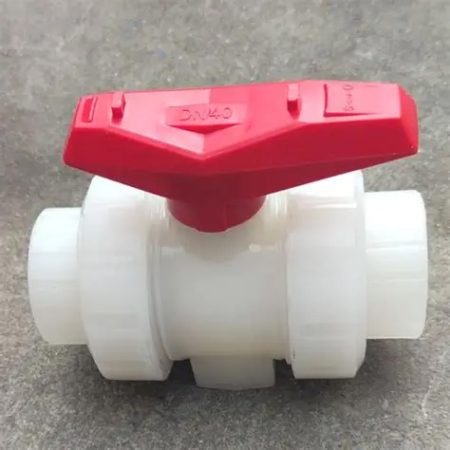
Acid-Base Production
Ball valves are important in acid-base production. They help control how acids and bases move. When you use strong chemicals, you need a valve that does not get damaged. A pvdf ball valve gives you this safety. It does not get ruined by acids or alkalis. You can use it in many places, like petrochemicals, pharmaceuticals, food and drink factories, and nuclear waste sites.
Here is a table that shows where ball valves are used in acid-base production:
| Application Area | Description |
|---|---|
| Petrochemicals | Used for moving strong fluids during making products. |
| Pharmaceuticals | Needed for chemical reactions and moving liquids. |
| Food and Beverage Processing | Makes sure food chemicals are safe and handled right. |
| Nuclear Waste Disposal | Keeps dangerous materials locked up safely. |
Ball valves are used in many jobs. They help stop leaks and keep things safe. The strong material helps them last longer, even in hard places.
Tip: Pick ball valves made from the best material for your job. This helps stop damage and keeps your system working well.
Organic Synthesis
In organic synthesis, you work with many strong chemicals. Ball valves help you control these chemicals during reactions. You need valves that do not get damaged by acids, bases, or solvents. The right material keeps your tools safe and helps your work go well.
You might use ball valves in test labs, pilot plants, or big factories. These valves help stop leaks and problems. They also make cleaning and fixing easier. When you use ball valves that resist chemicals, you get better results and fewer troubles.
Pesticide Manufacturing
Pesticide plants use many strong chemicals. You need ball valves that can handle these chemicals without breaking. If a valve gets damaged, it can leak and cause danger. Picking the right valve keeps workers and the environment safe.
Ball valves in these plants face acids, bases, and solvents every day. The valves must not get ruined to keep working well. You can trust these valves to last a long time, even with harsh chemicals. This saves money and stops work from being delayed.
Note: Ball valves that resist damage from chemicals help keep people safe and protect nature.
Chlor-Alkali Industry
Ball valves are used a lot in the chlor-alkali industry. This industry makes chlorine, caustic soda, and hydrogen. It uses saltwater and electricity to do this. These chemicals are very strong. They can harm most materials. You need valves that can handle tough chemicals. PVDF ball valves help control these chemicals safely.
The chlor-alkali process has many problems. The chemicals can cause corrosion fast. If you use the wrong valve, it might leak. Sometimes, the whole system can fail. PVDF ball valves help stop these problems. They resist corrosion from acids and alkalis. You can trust them to keep your system safe.
Here is a table that shows why PVDF ball valves work well in the chlor-alkali industry:
| Benefit | Description |
|---|---|
| Corrosion Resistance | PVDF ball valves resist strong chemicals in the chlor-alkali process. |
| Longevity | These valves last a long time, even in tough places. |
| Low Maintenance | PVDF ball valves need little fixing, so you save time and money. |
You find ball valves in many parts of a chlor-alkali plant. They control brine, chlorine gas, and caustic soda. These fluids can cause corrosion. PVDF ball valves keep these fluids inside the pipes. They help stop leaks. You do not have to worry about corrosion ruining the valve.
Tip: Check your system for corrosion often. Fixing problems early helps you avoid bigger trouble.
PVDF ball valves last longer than most metal valves. Metal valves can fail because of corrosion. PVDF ball valves keep working with strong chemicals. You save money because you do not replace them often. You also spend less time fixing them.
You can use ball valves in new and old chlor-alkali plants. They fit with other equipment easily. They work in high-pressure and high-temperature systems. PVDF ball valves help your plant run safely and smoothly.
Note: Picking the right ball valves keeps workers and nature safe from leaks. PVDF ball valves help you feel safe when using harsh chemicals.
Other Types of PVDF Valves

PVDF Butterfly Valves
Sometimes you need to control big flows of acids or alkalis. PVDF butterfly valves make this job easy. These valves use a disc that turns to open or close the flow. You can put them in large pipes for quick shut-off. They also help you adjust the flow exactly how you want.
Here is a table that shows why PVDF butterfly valves work well with strong chemicals:
| Feature/Application | Description |
|---|---|
| Corrosion Resistance | Great at handling acids and bases. |
| Lightweight Design | Easy to install and ship, lighter than metal valves. |
| Precise Flow Control | Lets you control fluid flow very accurately. |
| Chemical Processing | Works well with acidic and alkaline fluids. |
| Pharmaceutical Industry | Keeps things pure and stops contamination. |
| Water Treatment | Controls water, wastewater, and other fluids. |
| Food & Beverage | Safe for some food uses because of FDA rules. |
| Semiconductor Manufacturing | Handles very clean water and strong cleaners. |
| Low Maintenance | Smooth surface stops buildup, so less cleaning is needed. |
| Wide Temperature Range | Works from very cold to hot temperatures. |
You can use PVDF butterfly valves in many places. They help keep your system safe and working well.
PVDF Diaphragm Valves
PVDF diaphragm valves let you control chemical flow very carefully. You use these valves when you need no leaks and very clean results. The soft diaphragm inside blocks the flow and helps stop leaks and dirt.
Look at this table to see how PVDF diaphragm valves compare to other valves:
| Feature | PVDF Diaphragm Valves | Other Valve Types |
|---|---|---|
| Chemical Resistance | Very strong | Sometimes not as good |
| UV Resistance | Yes | Often not |
| Leakage Prevention | No leaks | Sometimes leaks |
| Maintenance | Needs little fixing | Needs more fixing |
| Cleanliness | Very clean | May have hidden spots |
| Life Span | Lasts a long time | Depends on type |
You find PVDF diaphragm valves in medicine factories, chip plants, and chemical dosing systems. These valves help keep your work clean and safe.
PVDF Check Valves
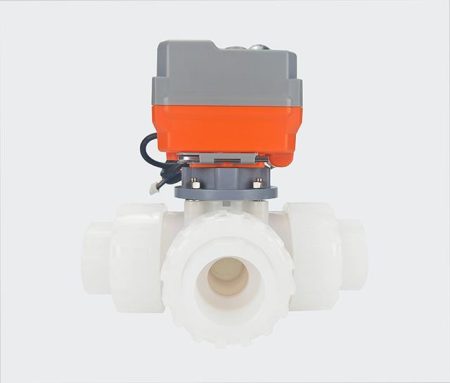
PVDF check valves keep fluids moving in one direction. You use them to stop liquids from going backward. This is important when you work with dangerous acids, alkalis, or solvents.
PVDF check valves have many good points:
- They resist lots of chemicals, like acids and bases.
- You can use them in chemical, medicine, and food factories.
- They work well in clean and hot places.
- Their strong build means they last a long time.
- They help keep things safe by stopping backflow.
Tip: PVDF check valves are great for pump lines and pipes where you must stop reverse flow.
System Flexibility and Safety
When you have different PVDF valve types, you can make safer and better systems. Each valve does a special job. You can pick the right valve for each part of your work.
| Valve Type | Function | Applications |
|---|---|---|
| PVDF Diaphragm Valve | Careful flow control | Medicine, chips, chemical dosing |
| PVDF Butterfly Valve | On/off and flow control for big pipes | Scrubbers, tanks, chemical lines |
| PVDF Check Valve | Stops backflow | Pump lines, vertical pipes |
| PVDF Pressure Relief Valve | Lets out extra pressure | Chemical injection, dosing systems |
| PVDF Solenoid Valve | Turns flow on or off with electricity | Automated dosing, labs, test systems |
| PVDF Sampling Valve | Takes clean samples safely | Quality checks in chemical and medicine work |
You can make your system safer and work better by picking the right PVDF valve. This helps you build strong systems that handle tough chemicals.
Selecting Ball Valves for Corrosive Environments
PVDF vs. PVC
PVDF and PVC ball valves are different in many ways. PVDF resists chemicals better than PVC. This is important when you use strong acids or bases. PVC works for lots of jobs, but not with very strong chemicals. PVDF is safer for tough chemical work. PVC costs less, so people use it for simple jobs. If you do not need the best protection, PVC is okay.
| Property | PVDF | PVC |
|---|---|---|
| Chemical Resistance | Superior, especially in harsh environments | Moderate, less resistant to extreme chemicals |
| Cost | Higher cost | More cost-effective |
| Applications | Ideal for chemical processing industries | Suitable for general-purpose applications |
Tip: PVDF ball valves last longer and are safer in chemical plants.
PVDF vs. CPVC
CPVC is another choice for ball valves. CPVC can handle more heat than PVC. PVDF works in even hotter and colder places. PVDF is stronger and can take more pressure. If your system needs to work in tough spots, PVDF is usually better.
| Material | Temperature Range | Mechanical Strength |
|---|---|---|
| PVDF | -40°C to 140°C | High-pressure capability due to superior mechanical strength |
| CPVC | -20°C to 110°C | Higher than UPVC, suitable for medium-pressure systems |
CPVC is good for medium jobs. PVDF ball valves are better for very hot, cold, or strong chemical places.
PVDF vs. Metal
Metal ball valves have been used for a long time. They are not always best for places with strong chemicals. PVDF ball valves do not rust or get ruined by chemicals. You do not have to worry about leaks or breaks from corrosion. PVDF stays strong in sunlight and heat. This helps if your system is outside or gets UV light.
- PVDF ball valves do not rust and are safe with chemicals.
- You can use them where sunlight or strong chemicals hurt metal.
- Metal ball valves work with higher heat and pressure.
- You might need metal for steam or very high-pressure jobs.
- Metal valves can rust fast in strong acids or bases. This means more fixing and lost time.
Note: Always use a guide to pick the right valve for your job. This keeps your system safe and working well.
Installation and Maintenance
Best Practices
You want your PVDF ball valves to work well for years. Good installation helps stop leaks and problems. Follow these easy steps for best results:
- Preparation Before Installation: Check all PVDF pipes and fittings for cracks or dirt. Work in a clean place to keep out dust.
- Joining Methods: Use the right joining method, like butt fusion or socket fusion. Always follow the maker’s instructions for heat and time.
- Support and Alignment: Hold up the pipes so they do not sag. Make sure everything is straight. This stops stress and damage when temperatures change.
- Testing and Inspection: After installing, test with pressure and look for leaks. Check that the valve is straight and moves easily.
- Safety Considerations: Wear gloves and goggles for safety. Fusion tools get very hot, so keep your area safe.
Tip: Careful installation keeps your system safe and helps your valves last longer.
Inspection
Regular checks help your PVDF valves work well. Use this table to guide your inspections:
| Inspection Protocols | Description |
|---|---|
| Follow Manufacturer Guidelines | Always use the instructions from the valve maker for best results. |
| Ensure Correct Alignment | Make sure the valve sits straight to prevent problems. |
| Use Appropriate Sealants | Pick the right sealant to stop leaks and keep the valve strong. |
| Routine Inspection and Cleaning | Check and clean the valve often to stop buildup and clogs. |
| Lubricate Moving Parts | Add lubricant to moving parts to reduce wear and keep things working. |
| Replace Worn Components | Change out old or damaged parts right away. |
| Troubleshoot Common Issues | Fix leaks or sticky parts quickly to avoid bigger problems. |
Note: Regular checks help you catch small issues before they become big problems.
Troubleshooting
If your PVDF valve leaks or does not work, you can fix it. Try these steps to solve problems:
- Look for water or drips near the valve.
- Check the stem and handle for leaks. Tighten or change seals if needed.
- Look at the joints and connections. Tighten them if you see leaks.
- Take the valve apart to check for dirt or damage. Clean out any buildup.
- Make sure the valve matches the chemicals in your system.
- Test the valve with pressure after you put it back together.
- If seals are worn, replace them right away.
- Put lubricant on moving parts and open and close the valve a few times.
- If leaks do not stop, use more sealing grease or get a new valve.
??? Quick fixes for leaks or sticky parts help your system stay safe and work well.
Safety and Compliance
Standards
You must follow rules when using PVDF ball valves. These rules help keep your system safe from leaks and corrosion. They also make sure your valves work well with strong chemicals. Many groups make these rules, and you should know the main ones.
Here is a table that shows important standards and what they mean:
| Standard/Certification | Description |
|---|---|
| API 608 Ball Valve | Sets rules for ball valves in many jobs. It checks if valves can handle different fluids, even strong ones. |
| API 607 Fire Safe | Makes sure valves still seal after a fire. This is needed for systems with dangerous or flammable fluids. |
| ASME B16.34 | Lists how to design valves for high pressure and heat. It helps you pick valves that last longer and resist corrosion. |
| ISO 17292 | Covers how to design and test industrial ball valves. It checks if valves work well with tough fluids. |
| ISO 9001 | Checks if the company makes good quality valves. It helps you trust the product. |
| High-Pressure Acidic Environments | Needs valves that resist corrosion and pass fire-safe tests, especially for sulfuric acid. |
Following these standards helps you stop leaks and costly problems.
Worker Safety
You need to keep workers safe when using strong chemicals. PVDF ball valves help lower risks, but you must use safe habits. Always teach your team to look for signs of corrosion on valves and pipes. Make sure everyone wears gloves, goggles, and protective clothes when working with acids or alkalis.
- Check valves often for leaks or corrosion.
- Put warning signs near places with dangerous fluids.
- Keep emergency showers and eye wash stations close by.
If you see corrosion on a valve, change it right away. Acting fast keeps everyone safe and stops spills.
??? Safety first: Clean and well-kept valve areas lower accident risks.
Documentation
Good records help you track how valves work and find problems early. You should keep a log of all valve checks, fixes, and changes. Write down when you see leaks or corrosion. This helps you spot patterns and fix things before they get worse.
- Write down the type of strong chemical each valve handles.
- Note any signs of corrosion during checks.
- List all maintenance steps and dates.
Clear records help you show your system follows safety rules. It also makes audits and checks easier.
Keeping good records protects your team and business from mistakes.
Future Trends
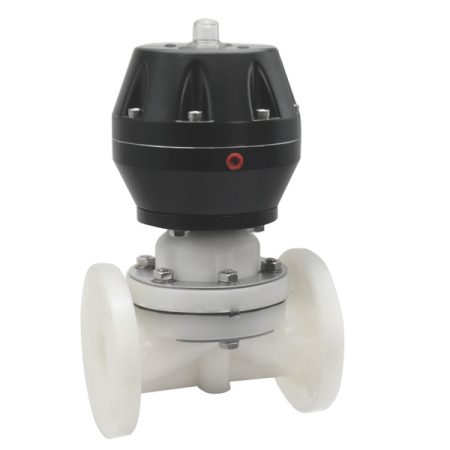
Material Innovations
New materials are changing how PVDF ball valves work. Engineers want valves to be stronger and safer. Some companies mix PVDF with other plastics. This helps the valves resist heat and chemicals better. These valves last longer and fight corrosion more. New coatings help stop corrosion before it starts. You can use these valves with strong acids or alkalis. Picking the right material protects your system and saves money.
Note: Always check if the new material works for your chemicals. Some materials are better with certain acids or bases.
Smart Valves
Smart valves are now used in many chemical plants. These valves have sensors that watch for leaks or corrosion. You get alerts if something is wrong. Smart valves help you fix problems early. You can connect these valves to computers and control systems. This lets you track fluid movement and valve performance. You save time and keep your plant safe.
Here are some things smart PVDF ball valves can do:
- Sensors find corrosion or leaks fast
- Wireless controls make using them easy
- Data tracking helps plan maintenance
- Automatic shut-off stops spills quickly
| Feature | Benefit |
|---|---|
| Leak Detection | Stops spills early |
| Corrosion Alerts | Prevents valve failure |
| Remote Control | Makes work safer |
| Data Logging | Helps plan repairs |
Smart valves help you avoid accidents and keep things running well.
Sustainability
You want your chemical plant to be safe for people and nature. PVDF ball valves help you reach this goal. These valves resist corrosion, so you do not replace them often. This means less waste and lower costs. Some companies recycle old valves and use eco-friendly materials. You can pick valves that use less energy to make and ship. When you choose valves that last longer, you help protect the environment.
Tip: Check for corrosion often to keep your system safe and cut down on waste.
More plants use green practices now. They pick valves that fight corrosion and use safe materials. This helps your plant meet safety rules and protect workers. It also shows customers you care about the planet.
You need something that can handle strong chemicals and hard places. A pvdf ball valve is very tough and resists chemicals well. It keeps working in places with lots of corrosion. You can use it for many jobs in chemical plants. Picking this valve helps your system stay safe and last longer. This is a smart way to protect your plant in the future.
FAQ
What makes PVDF ball valves better for acids and alkalis?
PVDF ball valves resist strong acids and alkalis. You get longer life and fewer leaks. The material does not corrode or break down easily.
Can you use PVDF ball valves in high-temperature systems?
Yes, you can use PVDF ball valves up to 280°F. The valves keep their shape and strength in hot chemical jobs.
How do you clean PVDF ball valves?
You clean PVDF ball valves with water or mild detergent. Avoid strong solvents. Regular cleaning stops buildup and keeps the valve working well.
Do PVDF ball valves need special installation tools?
You need standard fusion tools for PVDF ball valves. Always follow the manufacturer’s instructions for joining and sealing.
How often should you inspect PVDF ball valves?
You should inspect PVDF ball valves every three to six months. Look for leaks, corrosion, and wear. Regular checks help you catch problems early.
Are PVDF ball valves safe for drinking water systems?
Yes, PVDF ball valves meet safety standards for drinking water. The material does not add taste or odor to water.
What industries use PVDF ball valves most?
You find PVDF ball valves in chemical plants, water treatment, pharmaceuticals, and food factories. These valves work well in places with strong acids or alkalis.
Can you recycle PVDF ball valves?
Some companies recycle PVDF ball valves. You should check with your supplier for recycling programs. Recycling helps reduce waste and protect the environment.

